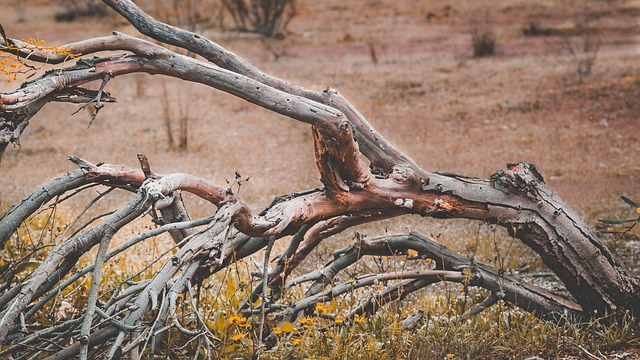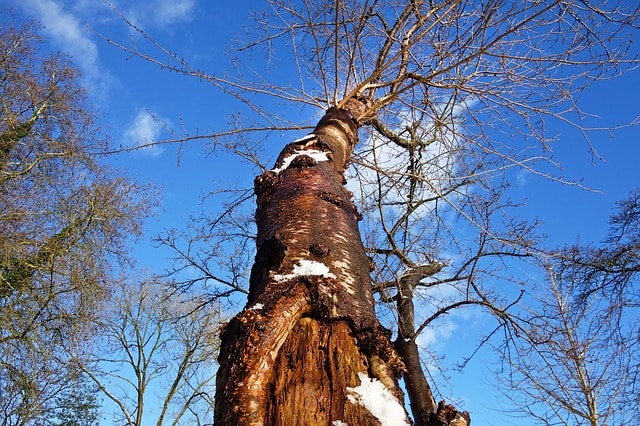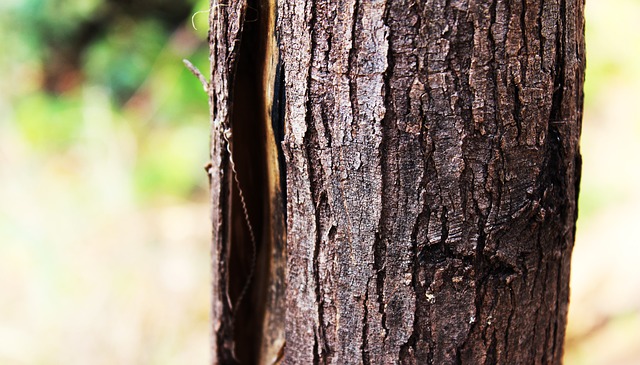While some trees last for hundreds of years, sadly, like all living things, all trees die eventually. While there have been cases of trees living for 5,000 years, some trees only last 40 or 50 years, so if you move into an older property with trees in the garden, then they may already be at the end of their natural life. So how do you know when a tree is dying, and is tree removal always necessary? Here are some of the key things to look out for.
- Bare branches
Unless it’s the dead of winter, your tree should have some signs of life on its branches. A tree without leaves in the spring or summer months can be a sign that it has died. However, if you spot leaves on your tree in the winter, this can also be a sign of tree death. Trees should naturally shed their leaves, but if they’re clinging to the branch, then your tree might have died.
- Weak joints
Branches that are loose and weak could indicate a dead or dying tree. Check the joints, which is where the branches meet the trunk, to see if they are sturdy. Weak joints can be dangerous, as it means branches can come loose during bad weather, so it’s important to get them checked over. They can sometimes be caused by branches growing close together, so bring in a professional to check the tree over.
- Damaged roots
Damaged roots are difficult to spot, as they are hidden underground, but there are a few things that can alert you to damaged roots:
- Leaning trees
- Epicormics shoots – these branches spout near the trunk of the tree, showing stress
- Reduced growth
- Leaves falling too early
These symptoms usually appear slowly, and worsen over time. Therefore, if you spot any of these issues, it’s best to get the tree looked over to see if it can be salvaged before the damage gets worse.
- Damaged trunk
Keep an eye on the trunk of your tree. Trees naturally develop vertical cracks as they age, with the bark falling off. In a healthy tree, there will be a layer of new bark underneath. Trees that are dead or diseased won’t grow this new layer of bark, so trunks that have a bare trunk or only a small amount of bark may well be at the end of their life.
Why should you get rid of a dying tree?
You might be wondering why a dead or dying tree is such a problem. After all, you might not notice it if it’s tucked away in your back yard. Here are a few reasons that a dead or dying tree should be removed.
Eyesore
A dead tree is not something that looks good in your garden. Without leaves and bark, they look pretty depressing, and can make the entire garden look neglected. Have it removed and you’ll reclaim the space, allowing you to plant something new.
Protecting other trees
If your tree has died because of a disease, it’s important to get it removed. Any disease can infect the other trees in your garden, leading to a costly problem. It’s much better to pay to get one tree removed, rather than risking all your garden’s greenery.
Attracting pests
Dead trees may not be attractive to your eyes, but to termites or rats they can be home. Unfortunately, this then puts the rest of your garden at risk, and means these pests could soon move on to infect your home. While you might not care about a dead tree getting infested, it can be worrying having pests in close proximity to your property.
How can I protect your trees?
While the death of a tree can sometimes be unavoidable, there are some steps you can take to prevent tree death.
- Give your trees space – keep the area around your tree clear, so it can breathe and get enough water
- Have your trees regularly pruned
- Have trees checked as soon as they show any of the above signs of dying
- Water your tree during dry spells – many people water the rest of the garden, but forget about their trees.
Some tree deaths can be prevented if caught in time, but it’s important to get expert advice so that the problem can be diagnosed properly.
If you have any problems with your trees, it’s important to get them checked by professionals. As with illnesses in humans, the earlier it’s caught, the better the chance of saving the tree. A tree expert will be able to diagnose the problem, and make suggestions for the best course of action. A dying tree won’t necessarily need to be removed, there may be other ways to address the problem.
Are Your Trees Suffering From Gum Tree Disease?
One Of The Most Common Tree Diseases In Australia
Gum trees, also known as eucalyptus trees, are a staple of the Australian landscape, and like all trees, they can be susceptible to a variety of diseases. These diseases can significantly impact the health of the trees and the broader ecosystem they support. The most common types of diseases affecting gum trees include fungal diseases, bacterial infections, and insect infestations.
Dieback (Phytophthora Cinnamomi)
One of the most common diseases affecting gum trees is caused by the fungus Phytophthora Cinnamomi, often called “dieback.” This pathogen infects the tree’s roots and prevents the uptake of water and nutrients, leading to the wilting and eventual death of the tree. Signs of this disease include yellowing leaves, branch dieback, and overall poor health of the tree. This disease is particularly devastating as it affects individual trees and can spread through soil and water, affecting large forest areas.
Myrtle Rust (Teratosphaeria Destructans)
Another common gum tree disease is caused by the fungus Teratosphaeria Destructans, commonly known as “myrtle rust.” This disease presents as bright yellow or orange spore masses on leaves, stems, and flowers. It can cause defoliation and reduced plant vigour, and in severe cases, can kill the tree.
Pests To Look Out For
Insect pests like the eucalyptus long-horned borer and the eucalyptus gall wasp can also affect gum trees. These pests can cause significant damage to the tree, leading to branch dieback and, in severe cases, tree death.
How To Prevent And Minimise Gum Tree Disease
Prevention and mitigation of these diseases require a combination of good cultural practices and targeted treatments. Good hygiene practices, such as not moving infected soil or plant material, can help prevent the spread of diseases like dieback. Regular inspection of trees for signs of disease can allow early detection and intervention, often resulting in a better outcome for the tree.
An integrated pest management approach is often the most effective when treating diseased trees. This can involve using fungicides or insecticides but should also include non-chemical methods, such as improving soil health and removing infected plant material.
How To Treat Dieback
For dieback specifically, improving soil drainage can help to prevent the disease, and infected trees can sometimes be saved by removing the affected roots and applying a phosphite treatment.
How To Treat Myrtle Rust
For myrtle rust, a fungicide can be applied, although the effectiveness of this is often limited. In the case of insect pests, natural predators can be a beneficial ally, and in severe cases, insecticides may be necessary.
If You Need Help With Gum Tree Disease, Call A Professional
Remember, though, that managing gum tree disease is a complex task and often requires professional assistance. If you suspect your trees may be infected, it’s a good idea to seek advice from a qualified arborist or plant pathologist. Also, these diseases can affect a range of other plant species as well, so it’s important to consider the health of your entire garden or forest area, not just individual trees.



